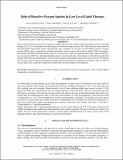| dc.contributor.author | Hamblin, Michael R. | |
| dc.contributor.author | Arany, Praveen R. | |
| dc.contributor.author | Huang, Ying-Ying | |
| dc.contributor.author | Chen, Aaron Chih-Hao | |
| dc.date.accessioned | 2010-03-19T17:46:21Z | |
| dc.date.available | 2010-03-19T17:46:21Z | |
| dc.date.issued | 2009-02 | |
| dc.identifier.issn | 0277-786X | |
| dc.identifier.uri | http://hdl.handle.net/1721.1/52743 | |
| dc.description.abstract | This review will focus on the role of reactive oxygen species in the cellular and tissue effects of low level light therapy (LLLT). Coincidentally with the increase in electron transport and in ATP, there has also been observed by intracellular fluorescent probes and electron spin resonance an increase in intracellular reactive oxygen species (ROS) such as superoxide, hydrogen peroxide, singlet oxygen and hydroxyl radical. ROS scavengers, antioxidants and ROS quenchers block many LLLT processes. It has been proposed that light between 400-500- nm may produce ROS by a photosensitization process involving flavins, while longer wavelengths may directly produce ROS from the mitochondria. Several redox-sensitive transcription factors are known such as NF-kB and AP1, that are able to initiate transcription of genes involved in protective responses to oxidative stress. It may be the case that LLLT can be pro-oxidant in the short-term, but anti-oxidant in the long-term. | en |
| dc.description.sponsorship | United States National Institutes of Health (R01CA/AI838801 and R01 AI050875) | en |
| dc.language.iso | en_US | |
| dc.publisher | The International Society for Optical Engineering | en |
| dc.relation.isversionof | http://dx.doi.org/10.1117/12.814890 | en |
| dc.rights | Article is made available in accordance with the publisher's policy and may be subject to US copyright law. Please refer to the publisher's site for terms of use. | en |
| dc.source | SPIE | en |
| dc.title | Role of reactive oxygen species in low level light therapy | en |
| dc.type | Article | en |
| dc.identifier.citation | Chen, Aaron Chih-Hao et al. “Role of reactive oxygen species in low level light therapy.” Mechanisms for Low-Light Therapy IV. Ed. Michael R. Hamblin, Ronald W. Waynant, & Juanita Anders. San Jose, CA, USA: SPIE, 2009. 716502-11. © 2009 SPIE--The International Society for Optical Engineering | en |
| dc.contributor.department | Harvard University--MIT Division of Health Sciences and Technology | en_US |
| dc.contributor.approver | Hamblin, Michael R. | |
| dc.contributor.mitauthor | Hamblin, Michael R. | |
| dc.relation.journal | Proceedings of SPIE | en |
| dc.eprint.version | Final published version | en |
| dc.type.uri | http://purl.org/eprint/type/JournalArticle | en |
| eprint.status | http://purl.org/eprint/status/PeerReviewed | en |
| dspace.orderedauthors | Chen, Aaron Chi-Hao; Huang, Ying-Ying; Arany, Praveen R.; Hamblin, Michael R. | en |
| mit.license | PUBLISHER_POLICY | en |
| mit.metadata.status | Complete | |
